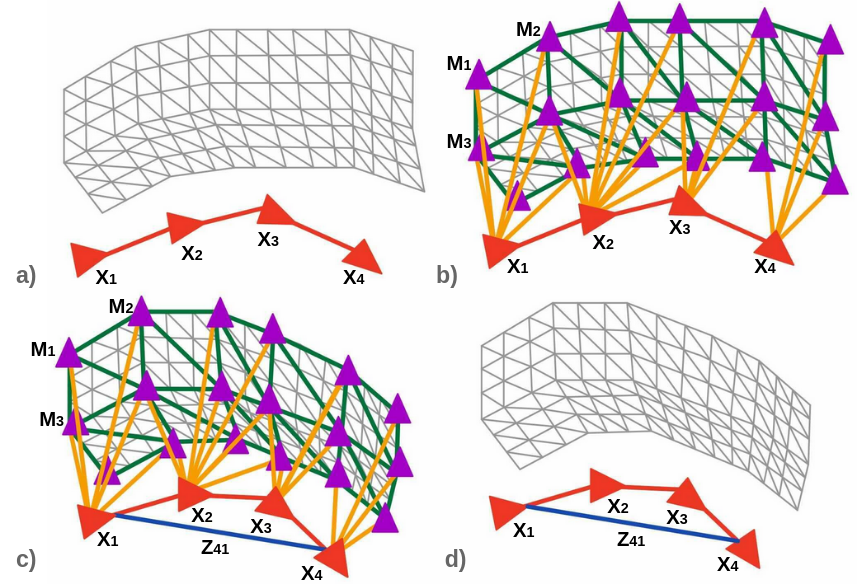Kimera-PGMO (Pose Graph and Mesh Optimizer) is an optimizer that takes in a mesh along with robot odometry and loop closure measurements and then optimizes for the trajectory and the mesh simultaneously. This is done by first creating a deformation graph using the pose graph, the mesh, and the time synchronized connections between the pose graph nodes and the mesh vertices. The optimization problem is then optimized using Kimera-RPGO.
If you find this library helpful or use it in your projects, please cite:
@article{rosinol21ijrr-kimera,
author = {Antoni Rosinol and Andrew Violette and Marcus Abate and Nathan Hughes and Yun Chang and Jingnan Shi and Arjun Gupta and Luca Carlone},
title ={Kimera: From SLAM to spatial perception with 3D dynamic scene graphs},
journal = {The International Journal of Robotics Research},
volume = {40},
number = {12-14},
pages = {1510-1546},
year = {2021},
doi = {10.1177/02783649211056674}
}In addition to PCL, OpenCV, and GTSAM, Kimera-PGMO is designed as part of Kimera, so the following Kimera packages and their dependencies are needed:
For the immediate dependencies, check out the rosinstall files.
cd ~/catkin_ws/src
wstool merge Kimera-PGMO/install/kimera_pgmo_ssh.rosinstall
wstool update
catkin build kimera_pgmohorizonis the compressor horizon. We are currently using an geometric octree based mesh simplification technique, vertices that is outside the horizon will no longer be in the octree allowing a new vertex to be places near it.output_mesh_resolutionresolution of the full mesh. Set to less than the Kimera-Semantics / Voxblox voxel size if you don't want any simplification on the full mesh.graph_comppression_methodsets the compression method to extract simplified mesh for deformation graph. Recommended:1.full_compression_methodsets the compression method for the full mesh. Recommended:2.robot_idcan be just set to the default0if running single robot. This is really only important for the multirobot case.d_graph_resolutionresolution of the simplified mesh to be added to the deformation graph.log_pathpath to the folder to save the mesh-frontend log file.log_outputtoggle to log timing and statistics.
output_prefixpath to the folder to save the log file and the optimized mesh and trajectory files.robot_idcan be just set to the default0if running single robot. This is really only important for the distributed multirobot case.run_modetoggles the different modes. Set to 0 to receive pose graph and mesh and perform simultaneous pose graph and mesh optimization. Set to 1 to optimize the mesh and subscribe to an optimized trajectory.use_msg_timetoggle to use message header stamp or ROS time when connecting pose graph nodes to mesh vertices.log_outputlog timing statistics.rpgo/sets various pose graph optimization parameters. See example config.add_initial_prioradds a prior factor on first node.covariance/sets the covariance. See example config.
In one terminal, launch Kimera-VIO-ROS with stereo dense:
roslaunch kimera_vio_ros kimera_vio_ros_uhumans2.launchThen launch kimera_pgmo:
roslaunch kimera_pgmo kimera_pgmo.launch dataset:=uHumans2Launch Kimera-Semantics:
roslaunch kimera_semantics_ros kimera_semantics_uHumans2.launch
For visualization, an rviz configuration is provided:
rviz -d $(rospack find kimera_pgmo)/rviz/uHumans2.rvizFinally play the rosbag.
rosbag play some_bag.bag --clock --pauseTo save the mesh, do
rosservice call /kimera_pgmo/save_meshand to save optimized trajectory, do
rosservice call /kimera_pgmo/save_trajectorythe mesh will be saved to ouput_folder/mesh_pgmo.ply and trajectory will be saved to output_folder/traj_pgmo.csv (see launch file)
You can also save the underlying deformation graph to output_folder/pgmo.dgrf
rosservice call /kimera_pgmo/save_dgrfYou may also directly load a .ply and .dgrf file to Kimera-PGMO
roslaunch kimera_pgmo kimera_pgmo.launch dataset:=uHumans2Start rviz:
rviz -d $(rospack find kimera_pgmo)/rviz/uHumans2.rvizAnd load mesh and deformation graph:
rosservice call /kimera_pgmo/load_graph_mesh '{robot_id: 0, dgrf_file: /home/yunchang/catkin_ws/src/kimera_pgmo/log/pgmo.dgrf, ply_file: /home/yunchang/catkin_ws/src/kimera_pgmo/log/mesh_pgmo.ply}'roscd kimera_pgmo
catkin run_tests --no-deps --this
catkin_test_results ~/catkin_ws/build/kimera_pgmo/You can also run individual tests for example:
rostest kimera_pgmo test_mesh_frontend.test --textOr
rosrun kimera_pgmo kimera_pgmo-test_deformation_graphOne thing to note if a developer is working with GTSAM and want to add other factors into the system is that here we specify different prefixes for different types of nodes in the deformation graph, take a look at utils/CommonFunctions.h for reference. By prefix we mean the key character as described here.

